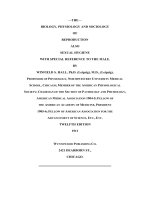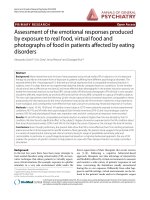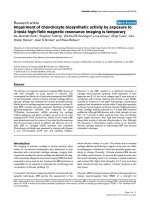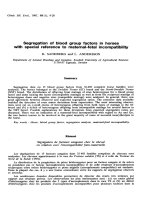Investigation of the pathogenesis caused by exposure to varying doses of VX nerve agent in rat with special reference to cardiotoxicity
Bạn đang xem bản rút gọn của tài liệu. Xem và tải ngay bản đầy đủ của tài liệu tại đây (19.8 MB, 201 trang )
INVESTIGATION OF THE PATHOGENESIS CAUSED
BY EXPOSURE TO VARYING DOSES OF VX NERVE
AGENT IN RAT WITH SPECIAL REFERENCE TO
CARDIOTOXICITY
FONG XIAO JUN
(B.Sc. (Hons)), NUS
A THESIS SUBMITTED
FOR THE DEGREE OF MASTER OF SCIENCE
DEPARTMENT OF ANATOMY
NATIONAL UNIVERSITY OF SINGAPORE
2006
To my Family
ACKNOWLEDGEMENTS
I would like to express my sincere appreciation and gratitude to my
supervisor, Professor P. Gopalakrishnakone, Department of Anatomy, National
University of Singapore, for his patient guidance, encouragement and support through
the course of the whole project, as well as for his expertise in research.
I would like to thank Professor Ling Eng Ang (Head of Anatomy) for his
kind support and concern during my study.
I also wish to express my gratitude to Dr. Loke Weng Keong, DSO National
Laboratories, Singapore, for his kind assistance and valuable expertise in the area of
nerve agent research. I would like to thank Dr. Lee Fook Kay, DSO National
Laboratories, Singapore, for his kind concern and support. Special thanks shall be
extended to all staff of DSO National Laboratories, Singapore, particularly Mdm.
Soh Poh Chiang, Emily, Mdm. Chang May Ling, Joyce and Miss. Tan Yong
Teng for their invaluable help and assistance in my experiments and laboratory work.
I wish to specially thank the staff of Department of Anatomy, Mrs. Ng Geok
Lan, Mrs. Yong Eng Siang, Mdm. Manomani and Mdm. Thenmozhi of the
Histology Laboratory; Miss. Chan Yee Gek of the Electron Microscopy Unit; Mdm.
Bay Song Lin, Mr. Low Chun Peng and Mr Yick Tuck Yong of the Multimedia
Development Unit for their technical help and patient assistance. I would also like to
I
thank Mdm. Teo Li Ching, Violet, Mdm. Diljit Kour d/o Bachan Singh and Mdm.
Ang Lye Gek, Carolyne of the general office for their kind assistance and helpful
advice in all administrative-related work.
I would like to thank all academic staffs and postgraduate students in the
Department of Anatomy for their caring support and encouragement. I wish to thank
fellow research colleagues of Venom & Toxin Research Programme, Miss. Hema
d/o Jethanand, Dr. Pachiappan Arjunan, Dr. Maung Maung Thwin, Dr. R
Perumal Samy and Dr. Ramasamy Saminathan, for their kind and friendly support.
Finally, I hope to take this opportunity to express my gratitude and
appreciation to my family members for their endless support and encouragement
during my period of postgraduate study. They have been a constant inspiration and
have seen me through this important and valued phase of my academic pursuit.
II
TABLE OF CONTENTS
ACKNOWLEDGEMENTS
TABLE OF CONTENTS
SUMMARY
PUBLICATION
LIST OF ABBREVIATIONS
CHAPTER ONE
I
III
VII
IX
X
INTRODUCTION
1
1.1 Chemical warfare nerve agents
1.1.1 Introduction
1.1.2 Incidents of nerve agent use
1.1.3 Mechanism of action
1.1.4 Pathophysiology and effects on organ systems
1.1.5 Routes of exposure
1.1.5.1 Inhalation
1.1.5.2 Absorption through skin and mucous membranes
1.1.5.3 Ingestion
1.1.6 Chemical properties
1.1.7 Decontamination and treatment
2
2
4
4
7
9
9
11
12
12
15
1.2 Effects of VX (O-ethyl-S-2 diisopropylaminoethyl-methyl phosphonothiolate)
and other nerve agents
18
1.2.1 Histopathological findings
18
1.2.2 Electrocardiographical studies
24
1.3 Aims and significance of present study
28
CHAPTER TWO
32
MATERIALS AND METHODS
2.1 Supply of nerve agent VX
33
2.2 Chemicals and equipments
33
2.3 Animals
35
2.4 Biochemical analysis
2.4.1 Acetylcholinesterase assay
2.4.2 Creatine Kinase – MB test
35
36
37
2.5 Injection of nerve agent VX and drug treatment
37
III
2.6 Acute and chronic VX exposure protocols and observation of clinical signs
and symptoms of intoxication
38
2.7 Electrocardiographical studies
2.7.1 Telemetry system
2.7.2 Physiological parameters and calibration values
2.7.3 Implantation of electrocardiography transmitter
2.7.3.1 Surgical procedure
2.7.3.2 Post-operative regimen
2.7.4 Recording of electrocardiography signals and measurement of
electrophysiologic parameters
2.7.5 ECG recording schedule for toxicity tests
40
40
41
42
42
46
2.8 Histopathological studies
2.8.1 Perfusion and fixation
2.8.1.1 Preparation of fixative
2.8.1.2 Perfusion system
2.8.1.3 Perfusion pressure
2.8.1.4 Anaesthesia of animals
2.8.1.5 Perfusion
2.8.2 Processing of tissue specimens for light microscopy
2.8.2.1 Fixation and dehydration
2.8.2.2 Paraffin embedding
2.8.2.3 Microtome sectioning
2.8.2.4 Haematoxylin and Eosin (H & E) staining
2.8.2.5 Observation with light microscope and histologic scoring
50
50
50
51
51
52
53
54
54
54
55
55
56
2.9 Statistical analysis
57
CHAPTER THREE
OBSERVATIONS AND RESULTS
46
49
58
3.1 Acute 1.6 LD50 VX with drug treatment
3.1.1 Clinical observations after injection
3.1.2 Weight profile
3.1.3 Acetylcholinesterase activity
3.1.4 Histopathological changes
3.1.4.1 Cardiac muscle
3.1.4.2 Kidney
3.1.4.3 Skeletal muscle
3.1.4.4 Liver
3.1.4.5 Lungs
59
59
61
63
64
64
72
76
80
83
3.2 Acute 1 LD50 VX injection
3.2.1 Clinical observations after injection
3.2.2 Weight profile
87
87
89
IV
3.2.3 Acetylcholinesterase activity
3.2.4 Time study profile of histopathological changes
3.2.4.1 Cardiac muscle
3.2.4.2 Kidney
3.2.4.3 Skeletal muscle
3.2.4.4 Lungs
3.2.4.5 Liver
3.2.5 Correlation between cardiac damage and convulsions
3.2.6 Electrocardiography
3.2.6.1 Day of exposure
3.2.6.1.1 Physiologic and electrocardiographic data
3.2.6.1.2 Cardiac rhythm
3.2.6.2 Post exposure -14 days
3.2.6.2.1 Physiologic and electrocardiographic data
3.2.6.2.2 Cardiac rhythm
91
92
94
99
102
104
106
106
107
107
107
114
124
124
132
3.3 Chronic 0.4 LD50 VX injections
3.3.1 Clinical observations after injection
3.3.2 Weight profile
3.3.3 Acetylcholinesterase activity
3.3.4 Histopathological changes
3.3.4.1 Cardiac muscle
3.3.4.2 Kidney
3.3.4.3 Skeletal muscle
3.3.4.4 Lungs
3.3.4.5 Liver
3.3.5 Correlation between cardiac damage and convulsions
3.3.6 Electrocardiography
3.3.6.1 Physiologic and electrocardiographic data
3.3.6.2 Cardiac rhythm
137
137
141
143
145
147
147
148
148
149
149
151
151
162
3.4 Creatine kinase – MB activity
165
CHAPTER FOUR
167
DISCUSSION AND CONCLUSION
4.1 Histopathological findings in acute and chronic VX poisoning
168
4.2 Electrocardiographical changes in acute high dosage and chronic low
dosage VX challenges
175
4.3 Conclusions
178
4.4 Directions for further research
180
V
REFERENCES
182
VI
SUMMARY
Cardiotoxicity was investigated in rats challenged with an organophosphorus
chemical warfare nerve agent VX, S-(2-diisopropylaminoethyl)-O-ethylmethyl
phosphonothiolate. A paucity of literature on chronic low dose VX challenges and
electrocardiographic investigations in VX exposure necessitate the need for research
in the respective areas. Three groups of rats followed three different dosing protocols
and various organs in addition to cardiac tissues were examined for histopathological
changes. Cardiotoxicity was determined by electrocardiography studies as well.
Assays for acetylcholinesterase activity were performed to determine the level of
enzyme inhibition due to VX.
Acute single doses of 1.6 LD50 VX were injected subcutaneously into rats
which received treatment drugs namely pyridostigmine bromide, atropine methyl
nitrate and pralidoxime chloride to ensure survival. All animals presented tonic-clonic
convulsions. Light microscopic observations of the cardiac muscles revealed severe
myocardial damage such as mononuclear cellular infiltration, myofibre degeneration
and necrosis in all of the VX-challenged rats. However, morphological changes in
other organs were minimal.
In the group of rats that received acute dosages of 1 LD50 VX in the absence
of drug treatment, light microscopy examinations were carried out on day 1, 2, 5, 9
and 14 following intoxication to capture the time profile of the appearance of organ
VII
damages. The degree of myocardial degeneration and necrosis were moderate up to
day 5 and reparation of the cardiac lesions was detected as early as day 9 postexposure. Myocardial lesions were rarely observed on day 14 post-intoxication. As in
the 1.6 LD50 VX group, injuries in other organs were infrequently observed.
Electrocardiography recordings revealed QTc and PR interval prolongations in
addition to abnormalities in cardiac rhythm (atrioventricular blocks, arrhythmias and
‘Torsade de pointes’ ventriclar tachycardia) in the intoxicated rats. The
electrocardiographic irregularities were detected up to day 14 post-injection.
In the third dosing regimen, chronic low doses (0.4 LD50) of VX were
administered subcutaneously daily up to 8 days. Clinical symptoms of nerve agent
intoxication started appearing from the fourth day of injection.
The rats were
perfused for histologic evaluations 24 hours after designated dosing days (dosing day
1, 3, 4 and 8). Histopathological studies revealed the presence of myocardial damage
on the fourth and eighth days of dosing. Histopathological changes in other organs
were
uncommon.
Electrocardiography
measurements
demonstrated
cardiac
arrhythmias as early as the second day of dosing, before the appearance of clinical
symptoms specific for nerve agent intoxication. Significant lengthening of QTc and
PR intervals was evident from the first day of injection. The aberrations in cardiac
rhythm and QTc prolongations were reproducible up to 5 days after the last dosing
day i.e. dosing day 8. This is a novel finding in the research of cardiac toxicity of
nerve agents.
VIII
PUBLICATION
Internationally accepted conference abstract:
Fong XJ, Gopalakrishnakone P, Loke WK and Lee FK. (2006) Investigation on
possible delayed cardiotoxicity arising from chronic exposure to low levels of VX
nerve agent. Symposium on chemical, biological, nuclear and radiological threats, NBC
2006. 18th – 21st June 2006, Tampere, Finland.
IX
LIST OF ABBREVIATIONS
ACh
Acetylcholine
AChE
Acetylcholinesterase
AV
Atrioventricular
CK-MB
Creatine kinase – MB
CNS
Central nervous system
Ct
Concentration-time function
DD
Dosing day
ECG
Electrocardiography
GA
Tabun
GB
Sarin
GD
Soman
GF
Cyclosarin
g
Gram
H&E
Haematoxylin and eosin stain
hr
Hour
ICt50
Ct that incapacitates 50% of exposed victims
i.m.
Intramuscular
i.p.
Intraperitoneal
kg
Kilogram
LCt50
Ct that kills 50% of exposed victims
LD50
Dose that kills 50% of exposed victims
X
MCt50
Ct that produces miosis in 50% of exposed victims
mg
Milligram
min
Minute
ml
Millilitre
mM
Millimolar
NaCl
Sodium chloride
PNS
Peripheral nervous system
QTc
QT interval corrected for heart rate
s.c.
Subcutaneous
SEM
Standard error of the mean
TdP
Torsades de pointes
VX
S-(2-diisopropylaminoethyl)-O-ethylmethyl phosphonothiolate
2-PAM
Pralidoxime chloride
µg
Microgram
µl
Microlitre
ºC
Degree Celsius
ºF
Degree Fahrenheit
XI
CHAPTER ONE
INTRODUCTION
1
CHAPTER ONE INTRODUCTION
1.1
CHEMICAL WARFARE NERVE AGENT
1.1.1
Introduction
Nerve agents belong to a diverse group of phosphorus-containing organic
chemicals
known
as
organophosphorous
compounds.
Organophosphorous
compounds include insecticides such as malathion, ophthalmic agents and
antihelmintics. The organophosphorous compounds were synthesized in the early
1800s when Jean Lassaigne esterified phosphoric acid with alcohol. Shortly thereafter
in 1854, Philip de Clermount reported the synthesis of tetraethyl pyrophosphate at a
meeting of the French Academy of Sciences. Eighty years later, Dr Gerhard Schrader,
a German chemist in the I. G. Farbenindustrie laboratory in Leverkusen, investigated
the
use
of
organophosphorous
compounds
as
insecticides.
The
use
of
organophosphorous compounds as insecticides was barred by the German military
and an arsenal of chemical warfare nerve agents was subsequently developed. During
World War II, in 1941, organophosphorous compounds were reintroduced worldwide
for pesticide use (Aaron and Howland, 1990).
Grouped into two main classes, G-series nerve agents are the precursors of the
V-series nerve agents. The members of the two classes share similar properties, and
are given both a common name and a two-character North Atlantic Treaty
Organisation (NATO) identifier. Synthesized by a group of German scientists led by
2
Dr Gerhard Schrader, there are four members in the G-series. The first nerve agent
synthesized was tabun (GA) in 1936. Sarin (GB) was discovered next in 1938,
followed by soman (GD) in 1944 and finally the cyclosarin (GF) in 1949 (Arnold,
2004).
The V-series is the second family of nerve agents which coincidentally also
consists of four members: VE, VG, VM and VX. It has been established that the Vseries nerve agents are approximately ten times higher in toxicity than the G-agent
sarin
(Benitez
et
al.,
2004).
S-(2-diisopropylaminoethyl)-O-ethylmethyl
phosphonothiolate (VX), invented in the 1950s at Porton Down in the United
Kingdom, is the agent in the V-series family that is most researched upon. The other
agents in the family have not been studied extensively and current literature on them
is scarce.
The nerve agents are classified as chemical weapons of mass destruction by
the United Nations according to UN Resolution 687. Production and stockpiling of
the agents was outlawed by the Chemical Weapons Convention of 1993 with the
Chemical Weapons Convention officially taking effect on April 29, 1997 (Paxman
and Harris, 2002).
3
1.1.2
Incidents of nerve agent use
Despite being synthesised during World War II as chemical warfare agents,
the nerve agents have not yet been utilised extensively in warfare. Few incidents
where nerve agents have been employed can be cited, such as in the Iran-Iraq war
from 1981 to 1988 where nerve agents were used, among other chemical weapons. In
addition, 5000 Iraqi Kurds were killed when Iraqis exposed the Kurdish village of
Halabja to nerve agents (Benitez et al., 2004).
However, incidents of poisoning arising from other organophosphate
compounds such as insectides are more common, whether they are suicidal or
accidental events. An example is the Jamaican ginger palsy incident in 1930 which
subsequently led to discovery of the mechanism of action of organophosphate
compounds (Furtado and Chan, 2004). The first nerve gas terrorism occurred in 1994
in the city of Matsumoto where about 600 of the citizens were exposed to sarin gas
(Okudera, 2002). In 1995, sarin was used again in a domestic terrorist attack by a
religious group Aum Shinrikyo in a Tokyo subway.
1.1.3
Mechanism of action
Typical of organophosphates, nerve agents disrupt the nervous system by
inhibiting acetylcholinesterase (AChE). AChE functions by hydrolysing and
inactivating
acetylcholine
(ACh),
a
neurotransmitter
which
mediates
4
neurotransmission in the central nervous system and peripheral nervous system. ACh
activates two classes of receptors, namely the muscarinic and nicotinic receptors.
Synapses are specialised junctions in the nervous system that relay signals
between neurons or between neurons and effector organs such as muscles or glands.
The presynaptic neuron or axon terminal contains neurotransmitter vesicles in which
the neurotransmitter ACh resides. The neurotransmitter vesicles dock at the
presynaptic neuron. Upon the arrival of an action potential or electrical impulse at the
presynaptic neuron, the release of ACh will be triggered. This happens when the
arriving nerve impulse bring about an influx of calcium ions into the presynaptic cell
through voltage-gated calcium ion channels. A biochemical cascade is then initiated
by the calcium ions which eventually results in the fusion of neurotransmitter vesicles
with the presynaptic membrane, thereby releasing ACh into the synaptic cleft (Kandel
et al., 2000; Bear et al., 2001).
Fig. 1.1 Events at a neuronal synapse
5
As shown in Fig. 1.1, ACh diffuses across the synaptic cleft to the membrane
of the postsynaptic cell where it binds to its receptor. This ligand-receptor interaction
leads to activation of the ACh receptor which initiates an influx of sodium ions into
the postsynaptic cell. The entry of large amounts of positive ions changes the local
transmembrane potential of the cell thereby generating depolarisation. The
depolarisation results in signal transmission in the form of an action potential in the
postsynaptic cell. After the nerve impulse is sent and propagated, ACh is rapidly
degraded into choline and acetate by AChE. The choline moiety undergoes uptake
into the presynaptic cell and is used for re-synthesis of ACh. The hydrolysis of ACh
regenerates the receptor and renders it active and free for subsequent ligand binding
(Benitez et al., 2004). Hence, degradation of the neurotransmitter ACh by AChE
enables the cholinergic neuron to return to its resting state after activation.
The basic mechanism of action of organophosphate poisoning is by AChE
inhibition. Organophosphates inactivate AChE by phosphorylating a serine hydroxyl
group at the active site of AChE. Phosphorylation occurs by the loss of an
organophosphate leaving group and establishment of a covalent bond with AChE
(Leikin et al., 2002). The covalent bond which the organophosphate compound forms
with AChE is situated at the active site of the enzyme where acetylcholine normally
undergoes hydrolysis. Thus, AChE that is bound to organophosphates is incapable of
breaking down ACh. This leads to continued interaction of ACh with its receptor and
a build-up of the neurotransmitter. The result is persistent stimulation of ACh
receptors and continual transmission of nerve impulses.
6
1.1.4
Pathophysiology and effects on organ systems
Acetylcholine binds at the muscarinic receptors and nicotinic receptors. The
accumulation of acetylcholine at the receptor sites results in excessive cholinergic
stimulation of both groups of receptors. Muscarinic receptors are located in the
central nervous system (CNS) and in the peripheral nervous system (PNS) at
neuroeffector junctions of the parasympathetic portion of the autonomic nervous
system. Nicotinic receptors are located in the CNS, in the PNS sympathetic and
parasympathetic ganglia, and in the neuromuscular junctions (Walter et al., 2000).
The cholinesterase inhibitors act at all these sites in the CNS and PNS. Hence,
the signs and symptoms caused by nerve agent intoxication consist of nicotinic and
muscarinic signs and symptoms in both the CNS and PNS (Walter et al., 2000). The
signs and symptoms of nerve agent intoxication are summarized in Table 1.1.
7
Table 1.1 Signs and symptoms of nerve agent poisoning (Marrs et al, 1996a)
Peripheral Nervous System
Muscarinic
Nicotinic
Diarrhoea
Urination
Miosis
Mydriasis
Tachycardia
Weakness
Bradycardia,
bronchorrhoea,
bronchospasm
Emesis
Lacrimation
Salivation, secretion,
sweating
Hypertension,
hyperglycaemia
Central Nervous System
Confusion
Convulsions
Coma
Fasciculations
The extensive distribution of acetylcholinesterase, at both nicotinic and
muscarinic receptors throughout the PNS and CNS, can result in a variety of signs
and symptoms of poisoning. Inhibition of AChE may not account for all of the toxic
effects of nerve agents. These agents also are known to bind directly to nicotinic
receptors and cardiac muscarinic receptors. They also antagonize gammaaminobutyric acid (GABA) neurotransmission and stimulate glutamate N-methyl-daspartate (NMDA) receptors (Marrs et al., 1996a). These latter actions may partly
mediate nerve agent–induced seizures and CNS neuropathology.
Early clinical manifestations of nerve agent poisoning are the nicotinic signs
of intoxication. However, concurrent nicotinic and muscarinic signs and symptoms
are often present in both the PNS and CNS. In the later course of poisoning,
8
muscarinic signs and symptoms predominate. In severely poisoned cases, nicotinic
effect of depolarizing neuromuscular blockade, muscarinic PNS effects such as
bradycardia, and CNS effects such as coma are presented (Walter et al., 2000;
Furtado and Chan, 2004). Acute respiratory failure is the primary cause of death in
acute incidents of intoxication. Respiratory failure is caused by increased airway
resistance due to bronchorrhoea and bronchoconstriction, respiratory muscle
paralysis, and most importantly, loss of central respiratory drive (Arnold, 2004).
1.1.5
Routes of exposure
The emergence of symptoms and duration of action depend on the nature and
type of nerve agent, the amount and route of exposure, the mode of action of the
compound, lipid solubility and rate of metabolic degradation (Sidell and Borak,
1992). Routes of exposure to nerve agents include inhalation, absorption through the
skin or mucous membrane and ingestion.
1.1.5.1 Inhalation
The volatility of sarin, soman, tabun and VX at 77°F is 22000 mg/m, 3900
mg/m, 610 mg/m and 10.5 mg/m respectively (Watson et al., 2004). The G agents are
volatile liquids at normal ambient temperatures and they are significantly more
volatile than VX. Consequently, the most common route of exposure with the G
9
agents is inhalation. Inhalation of VX is possible but is much unlikely due to its
physical property of low vapour pressure.
Inhalation absorption of a nerve agent takes place within seconds. Exposure to
low concentrations of nerve agent vapour produces immediate ocular effects,
rhinorrhoea and possibly dyspnoea. High concentrations of nerve agent vapour results
in immediate loss of consciousness, convulsions, paralysis, respiratory failure and
death. This is due to the rapid absorption of nerve agent vapour across the respiratory
tract which produces maximum inhibition of AChE (Arnold, 2004).
The effect of inhalational exposure to nerve agent vapour is dependent on the
nerve agent vapour concentration and the duration of exposure. For comparative
purposes, the concentration-time function (Ct) is used to describe the amount of a
nerve gas to which a victim is exposed. This term, expressed as Ct, is the
concentration in the air (C), in mg/m3, multiplied by the exposure time (t), in minutes.
The LCt50 is the Ct that kills 50% of exposed victims. ICt50 is the Ct that incapacitates
50% of the exposed victims. Incapacitation disables or deprives the victims of the
ability to live normally afterwards. In other words, permanent injury results in 50% of
the victims in ICt50 as opposed to death being the endpoint in LCt50. MCt50 is the Ct
that produces miosis in 50% of exposed victims (Marrs et al., 1996b). The table
below compares these various Ct values in mg·min/m3.
10
Table 1.2 Lethal, incapacitating, and miosis concentration-time products in
humans for inhalational exposure (Marrs et al, 1996b)
Nerve Agent
LCt50 (mg/m3)
ICt50 (mg/m3)
MCt50 (mg/m3)
Sarin (GB)
100
75
3
Soman (GD)
70
Unknown
<1
Tabun (GA)
400
300
2–3
VX
50
35
0.04
LCt50, concentration time function that kills 50% of exposed victims;
ICt50, concentration time function that incapacitates or causes permanent disability in
50% of exposed victims;
MCt50, concentration time function that produces miosis in 50% of exposed victims.
1.1.5.2 Absorption through skin and mucous membrane
The effect of dermal exposure to liquid nerve agent depends on the anatomic
site exposed, ambient temperature and dose of nerve agent. Percutaneous absorption
of nerve agent typically results in localized sweating caused by direct nicotinic effect
on the skin, followed by muscular fasciculations and weakness. The latter effects are
due to the agent penetrating into the skin to exert a nicotinic effect on the underlying
muscle. In moderate dermal exposures, vomiting and diarrhoea may be expected
(Arnold, 2004).
The onset of symptoms following most dermal exposures is usually delayed
up to several hours as percutaneous absorption takes time. However, VX is a
persistent agent and is well absorbed through the skin after minimal contact time
(Craig et al., 1977). The dermal LD50 of VX or LCLo, which is the concentration of
VX that is needed to cause lethality in 50% of people via percutanous exposure, is
86µg of VX per kg of body weight (Sidell, 1997; Hurlbut and Lloyd, 1999). This
11
translates into an LCLo of approximately 6 mg of VX for a 70 kg adult human. In
comparison, the dermal LD50 for contact with liquid tabun, sarin, and soman is
approximately 1610 mg, 1960 mg, and 1260 mg, respectively (Watson et al., 2004).
1.1.5.3
Ingestion
Exposure of nerve agent via ingestion is largely uncommon, except in cases
where ingestion of droplets occurs from a line or point source spraying device. As in
dermal exposures, introduction of nerve agents via ingestion have a delayed but
abrupt onset of signs and symptoms (Benitez et al., 2000).
1.1.6
Chemical properties
The chemical properties of the more commonly reported nerve agents are
presented in Table 1.3.
12









